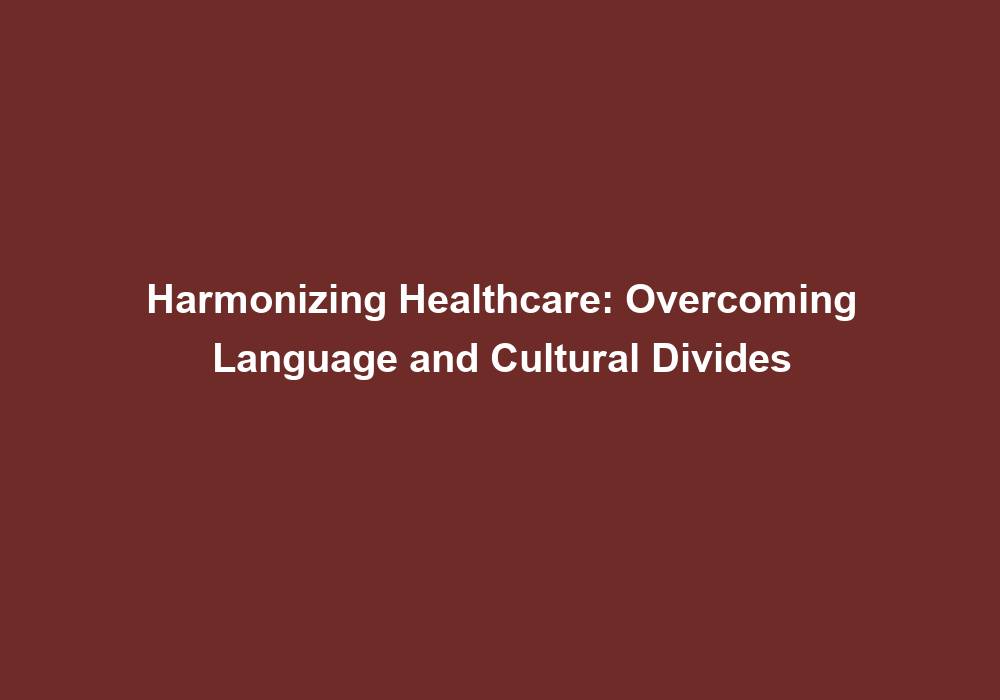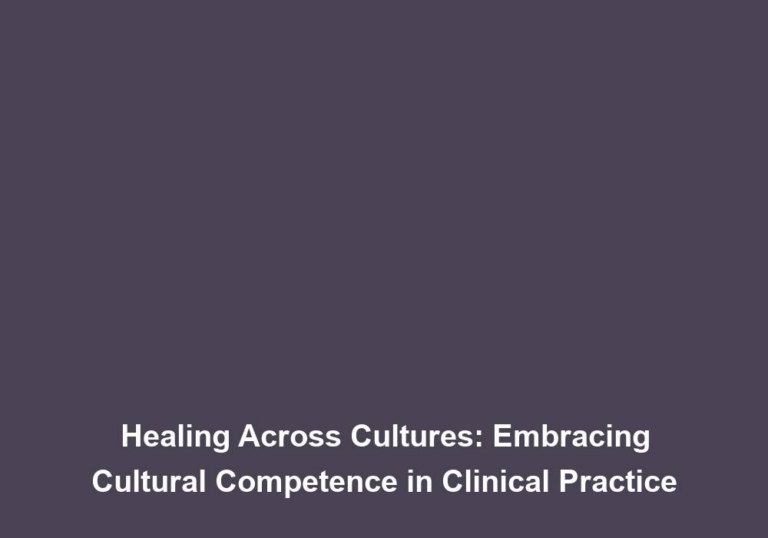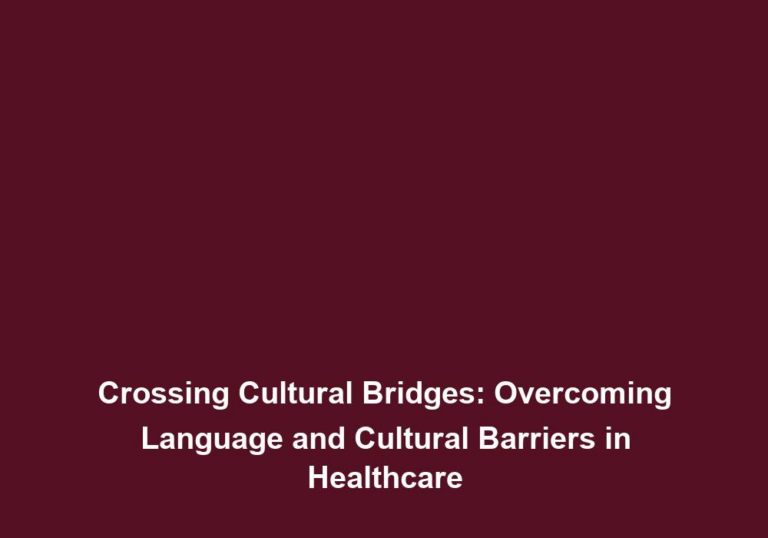Harmonizing Healthcare: Overcoming Language and Cultural Divides
In today’s diverse and interconnected world, healthcare providers face the challenge of serving patients from different cultural and linguistic backgrounds. Effective communication is essential in the healthcare industry to ensure accurate diagnoses, safe treatments, and overall patient satisfaction. Language and cultural barriers can hinder effective communication, leading to misunderstandings, medical errors, and compromised healthcare outcomes.
To bridge these divides and deliver harmonized healthcare, healthcare providers must adopt strategies and tools that promote effective communication and cultural understanding. This article explores some of the key challenges faced in overcoming language and cultural divides in healthcare and provides valuable insights into how these challenges can be addressed.
The Importance of Effective Communication in Healthcare
Effective communication lies at the core of delivering quality healthcare services. It is crucial for healthcare providers to understand their patients’ symptoms, medical histories, and concerns accurately. However, when patients and healthcare providers do not share a common language, communication becomes challenging.
Language barriers can lead to misunderstandings and prevent healthcare providers from accurately diagnosing and treating their patients. Without clear communication, patients may struggle to convey crucial information about their symptoms or medical history, which can result in misdiagnosis or delays in treatment. Furthermore, effective communication is essential for informed consent, as patients need to fully understand their treatment options and potential risks.
Challenges in Overcoming Language Barriers
Limited Access to Language Services
One of the primary challenges faced in overcoming language barriers is the limited access to language services in healthcare settings. Many healthcare facilities lack dedicated interpreters or translators who can facilitate communication between patients and healthcare professionals. This limitation can result in misdiagnosis, delays in treatment, and overall dissatisfaction among patients.
To address this challenge, healthcare organizations should prioritize investing in professional language services. Qualified interpreters, both onsite and remote, should be readily available to assist in the communication process. Additionally, healthcare facilities should establish partnerships with professional translation services to ensure that written materials, such as medical forms and educational resources, are accessible in multiple languages.
Inaccurate Use of Language Services
Even when language services are available, their effectiveness can be compromised if not used appropriately. Healthcare providers may rely on ad-hoc interpreters, such as family members or bilingual staff, who may not possess the necessary language and interpreting skills. This can lead to misinterpretations, loss of information, and compromised patient safety.
To overcome this challenge, healthcare professionals should receive training on how to effectively utilize language services. They should be educated on the importance of using professional interpreters and the potential risks associated with relying on untrained individuals. By understanding the limitations of ad-hoc interpreters and the benefits of professional language services, healthcare providers can ensure accurate and effective communication with their patients.
Cultural Misunderstandings
In addition to language barriers, cultural differences can also pose significant challenges in healthcare settings. Patients from diverse cultural backgrounds may have different beliefs, values, and healthcare practices. These differences can affect treatment adherence, trust in healthcare providers, and overall patient satisfaction.
To address cultural misunderstandings, healthcare providers should prioritize cultural competence training. This training should include education on different cultural practices, beliefs, and communication styles. By understanding and respecting diverse cultural backgrounds, healthcare professionals can establish trust and rapport with their patients. Additionally, healthcare providers should be open to learning from their patients and adapting their approaches to align with the cultural preferences and needs of each individual.
Strategies for Overcoming Language and Cultural Divides
Implementing Professional Language Services
Healthcare facilities should invest in professional language services to ensure accurate and effective communication with patients. These services may include qualified interpreters, both onsite and remote, as well as professional translation services for written materials. By utilizing these services, healthcare providers can minimize the risk of miscommunication and enhance patient safety.
In addition to providing language services, healthcare organizations should establish protocols and guidelines for their utilization. These protocols should outline when and how to involve interpreters or translators, ensuring that their services are integrated into the healthcare workflow seamlessly. Regular training and evaluation of language service providers should also be conducted to maintain quality and address any emerging needs.
Training Healthcare Professionals
Healthcare professionals should undergo training to develop cultural competence and linguistic skills. By understanding and respecting diverse cultural practices, healthcare providers can establish trust and rapport with their patients. Additionally, linguistic training can help healthcare professionals communicate basic medical information in patients’ native languages, fostering better understanding and engagement.
Cultural competence training should be an ongoing process, as it requires healthcare professionals to continually expand their knowledge and adapt their practices to meet the needs of diverse patient populations. This training should cover topics such as cultural sensitivity, effective cross-cultural communication, and strategies for building trust and rapport with patients from different cultural backgrounds.
Utilizing Technology Solutions
Technological advancements have revolutionized healthcare communication. Healthcare organizations can leverage digital tools, such as video remote interpreting (VRI) systems and multilingual patient portals, to overcome language barriers. VRI systems allow real-time access to professional interpreters, enabling effective communication between patients and healthcare providers. Multilingual patient portals provide patients with access to their medical records and educational materials in their preferred languages, enhancing patient engagement and empowerment.
When implementing technology solutions, healthcare organizations should consider factors such as ease of use, compatibility with existing systems, and data security. Training should also be provided to healthcare professionals to ensure they are proficient in utilizing these technologies effectively. Regular assessments and updates of technology solutions should be conducted to keep pace with advancements and address any emerging needs.
Culturally Sensitive Care
Providing culturally sensitive care is essential in promoting patient trust and satisfaction. Healthcare providers should familiarize themselves with the cultural backgrounds of their patients and tailor their approaches accordingly. By acknowledging and respecting cultural differences, healthcare professionals can foster a more inclusive and patient-centered environment.
Culturally sensitive care goes beyond language and involves understanding the cultural nuances that influence patients’ healthcare experiences. Healthcare providers should be mindful of cultural practices, beliefs, and values when developing treatment plans and providing care. By involving patients in shared decision-making and considering their cultural preferences, healthcare providers can enhance patient satisfaction and improve healthcare outcomes.
Conclusion
In an increasingly diverse society, healthcare providers must prioritize overcoming language and cultural divides to deliver harmonized healthcare. By implementing strategies such as professional language services, cultural competence training, technological solutions, and culturally sensitive care, healthcare organizations can ensure effective communication and better patient outcomes. The goal is to create an inclusive healthcare environment where patients receive the care they need, regardless of their cultural or linguistic backgrounds.






